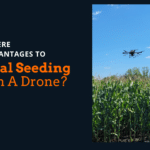The use of cover crops in organic farming can play an important role on a certified organic farm. While their use varies depending on growing conditions and crop rotation, it goes without saying that their use can be challenging on certified organic farms.
Why Cover Crops Are Not Used On Organic Farms
Before we discuss how to make cover crops a more viable tool on a certified organic farm, let’s first discuss one of the main reasons why they are not used.
One of the major reasons why farmers shy from use on their certified organic farming operations is planting schedules and weed control activities. For those who farm organically, it’s critical that up until you can no longer cultivate, you are investing heavily into mechanical weed control. Whether this is tine weeding, cultivating, utilizing a rotary hoe, weed zapping, or something else, you’re in the field working the soil to fight the battle against invasive weeds.
Once the last cultivation pass of the season has been made, the crops have likely reached a point in their growth that re-entering the field to plant a cover crop would be unfeasible until harvest. In many cases across North America, cover crops are not planted until the crops have been harvested.
This, unfortunately, makes it difficult to justify their use on an organic farm. Typically, once harvest season rolls around, it’s all systems go until the grain is in the bin and any time remaining is used for spreading fertilizer or completing fall cultivation.
Enter, the use of a drone. Aerial seeding cover crops with a drone provides many advantages, though there can be certain risks. It’s important that when you consider the use of cover crops, there is an understanding of the cost benefit. After all, your bottom line should dictate whether certain strategies either are or are not used on your farm.
How To Make Cover Crops Work On An Organic Farm
There is little debate that cover crops add value to an organic farm. They’re used to control erosion, suppress weeds, and primarily, to benefit the growth of crops planted the following season. Cover crops increase soil biodiversity and fix Nitrogen in the soil, giving a credit the following planting season.
Historically, planting a cover crop into a standing crop such as corn, was impossible until harvest. For reasons mentioned above, they simply were not a viable tool in anything outside of a no till farming operation.
Using A Drone To Aerial Seed Cover Crops
Over the past several years, long-time Crop Fertility Services employee Brian Halonen started the process of becoming certified to provide custom drone seeding services throughout the Upper Midwest.
The use of a drone to aerial seed cover crops provides many advantages, one of the biggest being that it allows us to seed cover crops while a crop is still standing, during ideal growing windows. Traditionally, this would simply not be possible due to the crop height.
Not only does aerial seeding cover crops with a drone provide many advantages, it’s accomplished during a critical growth period for these plants.
For many organic farmers, there are cover crop incentive programs in your county, that you should consider taking advantage of. If you have questions, please give Brian a call or text at (320)266-8072.
Plant When Conditions Are Ideal
Aside from the fact that standing crops prohibit the use of traditional planting methods, conditions late in the season reduce the viability for a cover crop to achieve any growth that season. Ideal planting time for cover crops in many situations is during the summer, which gives them time to do exactly what it is they’re designed to do!
Using a drone to seed cover crops allows us to effectively broadcast seed cover crops into a standing cash crop, giving them time to establish themselves and get to work in your soil.
The photo above shows our drone seeding cover crop into standing corn that would eventually be used as livestock forage. On the right hand side, this photo shows the cover crop that had the chance to grow between the rows, just prior to harvest.
Making Cover Crops Work On An Organic Farm
Making cover crops a viable tool on an organic farm is a topic of much interest amongst the organic farming community. By utilizing a drone, the difficulty of planting them is out the window.
We’d love the opportunity to speak with you about how we can put cover crops to work on your organic farm, give Brian Halonen of Elevated Ag Solutions a call at (320)266-8072 today, he’d be happy to answer any questions you may have!













